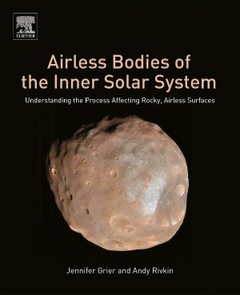Description
Airless Bodies of the Inner Solar System
Understanding the Process Affecting Rocky, Airless Surfaces
Authors: Grier Jennifer, Rivkin Andrew S.
Language: English
Subject for Airless Bodies of the Inner Solar System:
Keywords
Accretion; Airless bodies; Airless body; Asteroid; Asteroids; Astronomy; Celestial; Ceres; Cohesion; Concepts; Cratering; Craters; Creation; Data; Deimos; Delta-v; Discovery; Dust; Exploration; Gravity; Impact; Impactor; Investigation; Mercury; Meteorites; Moon; Movement; New Frontiers; Obliquity; Observations; Orbital elements; Phobos; Please check if the suggested by the editor are appropriate; If not; please provide no more than 6-8 .-->; Airless bodies; Processes; Radioactive; Regolith; Remote sensing; Resurfacing; Rocky; Solar radiation; Solar wind; Spacecraft; Spectroscopy; Techniques; Terrestrial; Transient lunar phenomena; Transport; Understanding; Vesta; Vis-viva equation; Volcanism; Weathering
98.24 €
In Print (Delivery period: 14 days).
Add to cart293 p. · 19x23.3 cm · Paperback
Description
/li>Contents
/li>Biography
/li>Comment
/li>
Airless Bodies of the Inner Solar System: Understanding the Process Affecting Rocky, Airless Surfaces focuses on the airless, rocky bodies in the inner solar system as a host unto themselves, with a unique set of processes that require a specific set of investigative techniques. The book allows readers to understand both the basic and advanced concepts necessary to understand and employ that information. Topics covered past exploration of these surfaces, changes with time, space weathering, impact cratering, creation and evolution of regolith and soils, comparison of sample and remote sensing data, dust characterization, surface composition and thoughts for future exploration.
Together these authors represent the unique combination of skills and experience required to produce an excellent book on the subject of the surfaces of airless, rocky bodies in the solar system, which will be useful both for graduate students and for working scientists.
In addition to research, Dr. Grier has broad interests in science education and public outreach. These interests include: scientist engagement in E/PO, the development of critical thinking skills, and imparting an understanding of our context within the Solar System and larger universe. Some of her specific education work has included: working with school systems to develop science curricula, partnering with science museums to vet exhibit content, offering professional development workshops to teachers and Girl Scout leaders, and teaching classes at the university level.
When not engaged in research or education projects, Dr. Grier: writes and reads science fiction stories and poetry, blogs at “Fictional Planet (onewritersmind.blogspot.com), makes and sells beaded gemstone jewelry, goes wine tasting, plays video games, and thinks about getting a cat.
At the Johns Hopkins University Applied Physics Laboratory, Andy Rivkin's research centers around near-infrared spectroscopy and spectrophotometry of asteroids, remotely dowsing the main belt. Much of his recent work can be found at the SMASS homepage, and a general webpage for the group he was in at MIT can be found here. He is also the Treasurer of the Division f
- Written by experts with a unique combination of skills and experience on the subject of the surfaces of airless, rocky bodies in the solar system
- Addresses the unique nature of airless bodies not done in any other reference
- Organized into subjects that can be easily translated into classroom lecture points
- Represents topics that scientists will want to pinpoint and browse



